cyberescudo
Newly Enlightened
- Joined
- Jan 24, 2016
- Messages
- 33
-For submission in the Reviews forum-
Fenix TK47 was provided by Fenix for review purpose.
There is also a version equipped with XHP70 and OP reflector called TK47 Ultimate Edition (UE)
REVIEW Fenix TK47 (XHP35 HI NW, Tail Light, 2x18650)



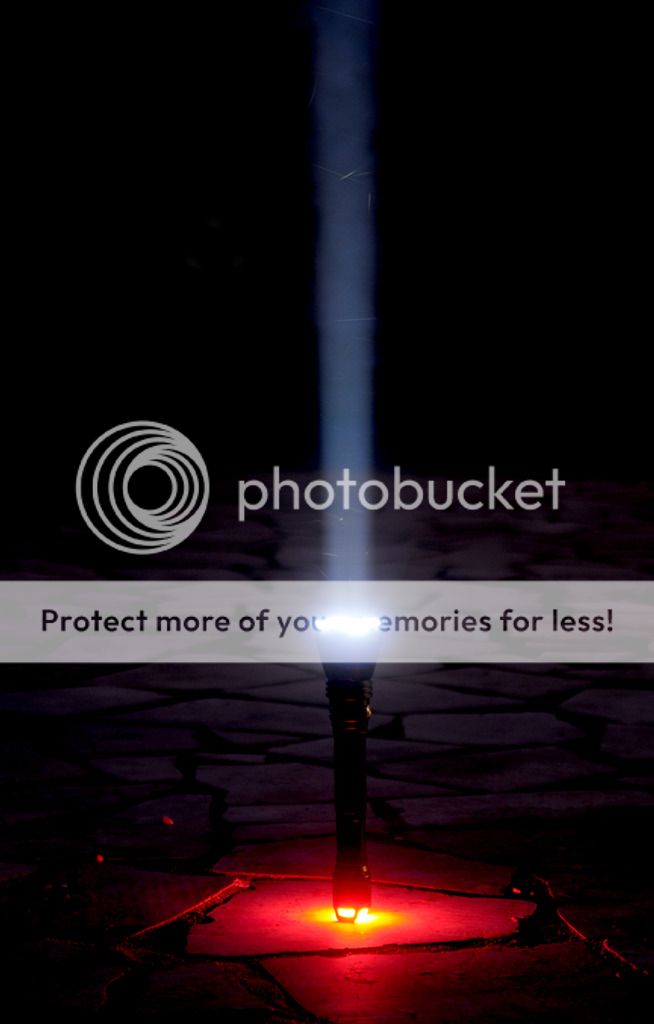




Manufacturer's Specs:
Packaging and accessories

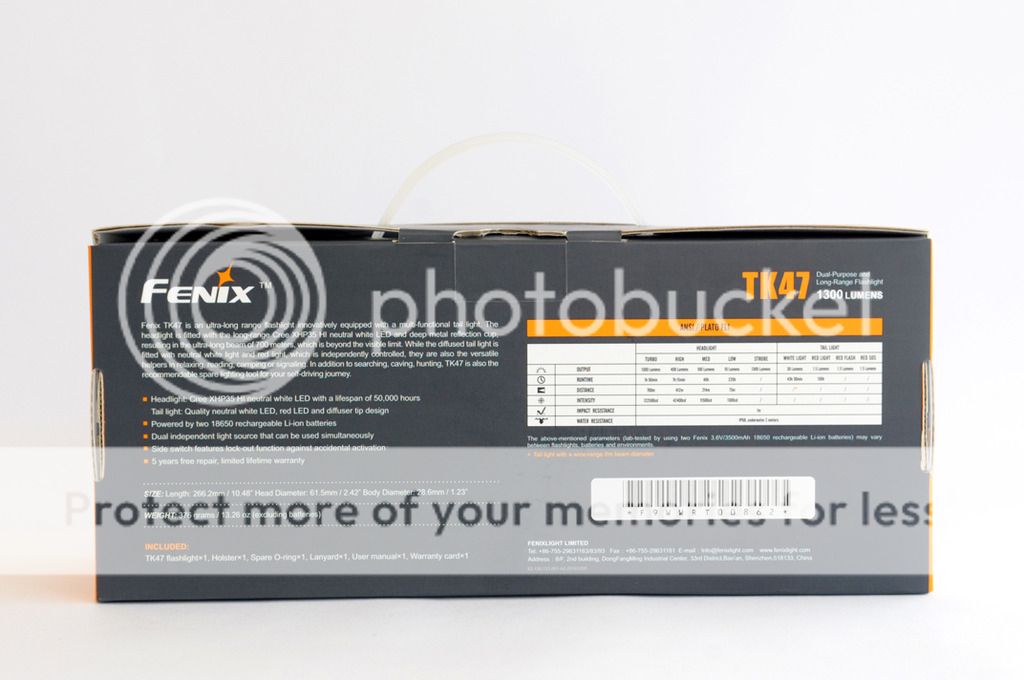
The Fenix TK47 is presented in a cardboard box with handle for transportation, are imprinted externally all the technical characteristics of the flashlight.
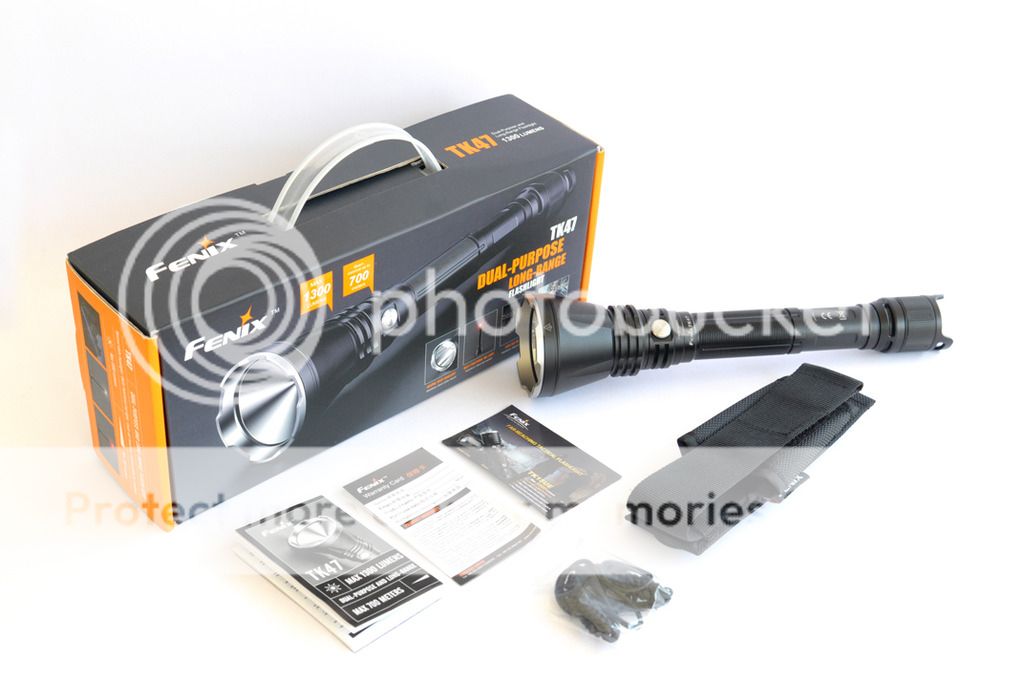
The Fenix TK47 kit of accessories includes: holster, lanyard, spare o-ring , multilanguage user manual, warranty card.


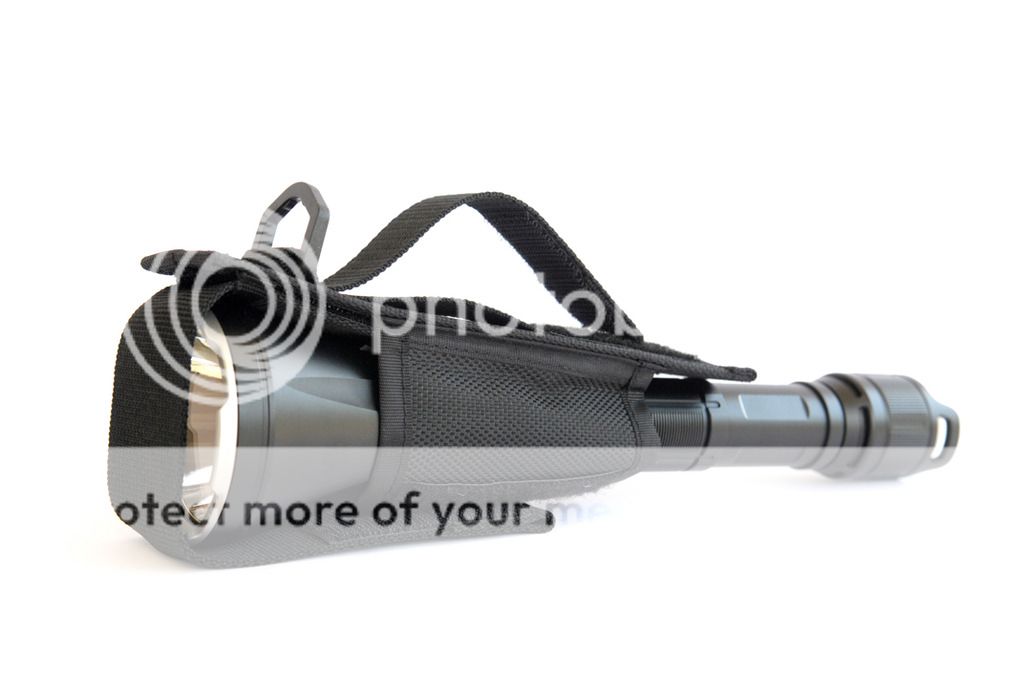
The cordura holster is well made and covers, given the remarkable length of the TK47, only the head of the flashlight allowing an upward carry.
The holster is closable with hook-and-loop fastener, the belt loop is wide enough for tactical belt.
Additional hooking attachments are MOLLE compatible connection and a plastic D-ring.

The lanyard is made of paracord.
How it's made


The TK47 is a new tactical flashlight from Fenix, powered by 2x18650, fitted with recent XHP35-HI led and smooth reflector, capable of a long range illumination of around 700 m.
A white/red tail light with integrated diffuser permits to use the flashlight like a white light soft lantern, for report writing using the red light or for signaling thanks to the red flash/SOS.
Each light source,independently controlled by the dedicated switch, is available in four levels so that the needs of the user can be satisfied.
Both the headlight and the tail light are in neutral tint providing a better color rendering.

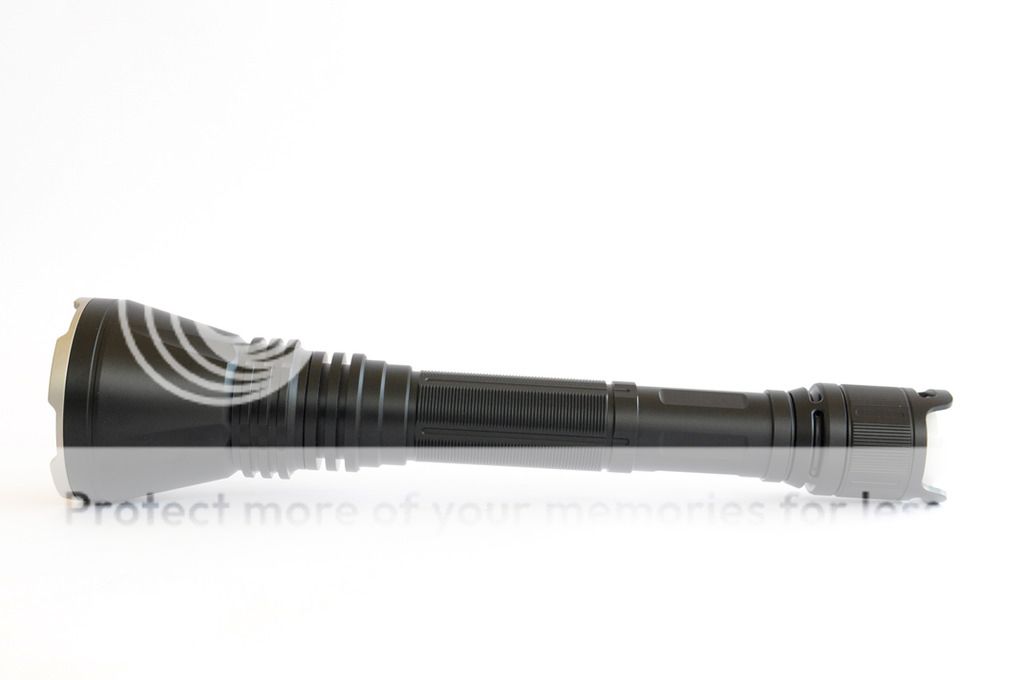
The design of this Fenix fully reflects the TK family of models, to which it belongs, that stand out for the finish tactics and sturdy construction.
Engravings are present on the flashlight pertaining to the model,serial number and CE certification.

The throw attitude is ensured by a generous size head that houses the factory dedomed led.



In the pics a dimensional comparison with XHP35 HI equipped lights, at left Imalent DN35 at right EagTac T25L-R.

With KaBar USMC.

The TK47 shows a dimensional profile which reveals a clear distinction between the head with a diameter of more than 60mm and the much more streamlined central body.
The dimensions are peculiar of tactical throwers in 2x18650 format that allows considerable performance in range while remaining easily grasped as a normal mono 18650, obviously it must be taken into consideration that the adoption of the two cells in series, brings the total length to become important. These dimensional sizes make the TK47 not an EDC but rather a searchlight to carry for a specific purpose.
The thickness is truly remarkable and indication of the renowned robustness of Fenix TK.


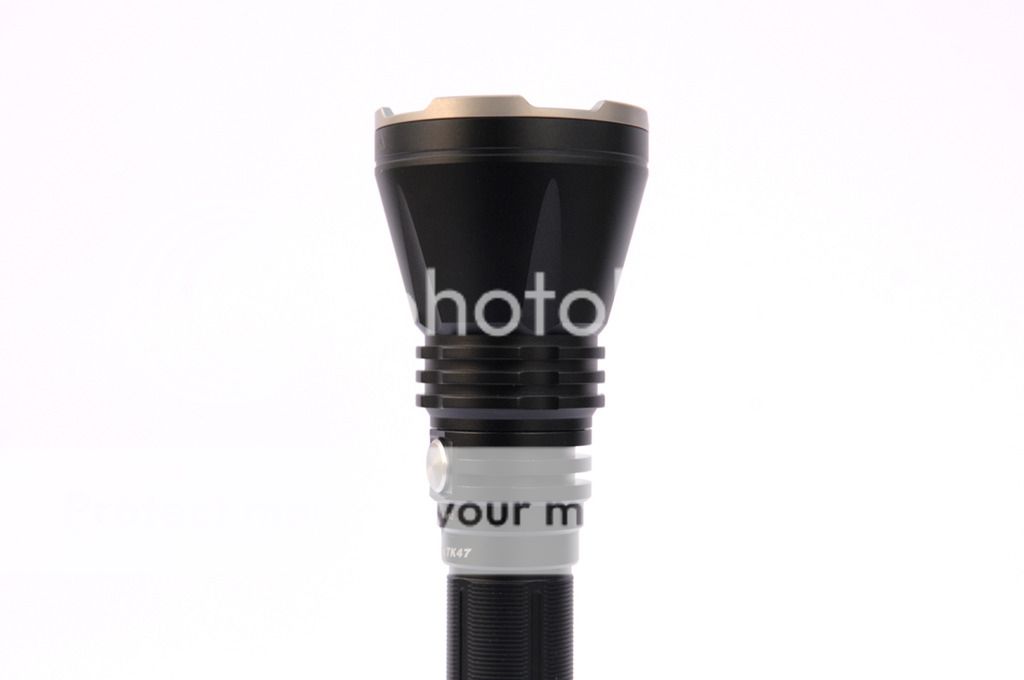
The head of the TK47 is basically divided into two parts: the one from the "cone with flat top" profile where there is the reflector ed in another from the cylindrical profile where it is present the driver with the side switch to manage the UI of the headlight.
The head parts are connected with each other and with the central body by threads, locked mechanically with threadlocking fluid.
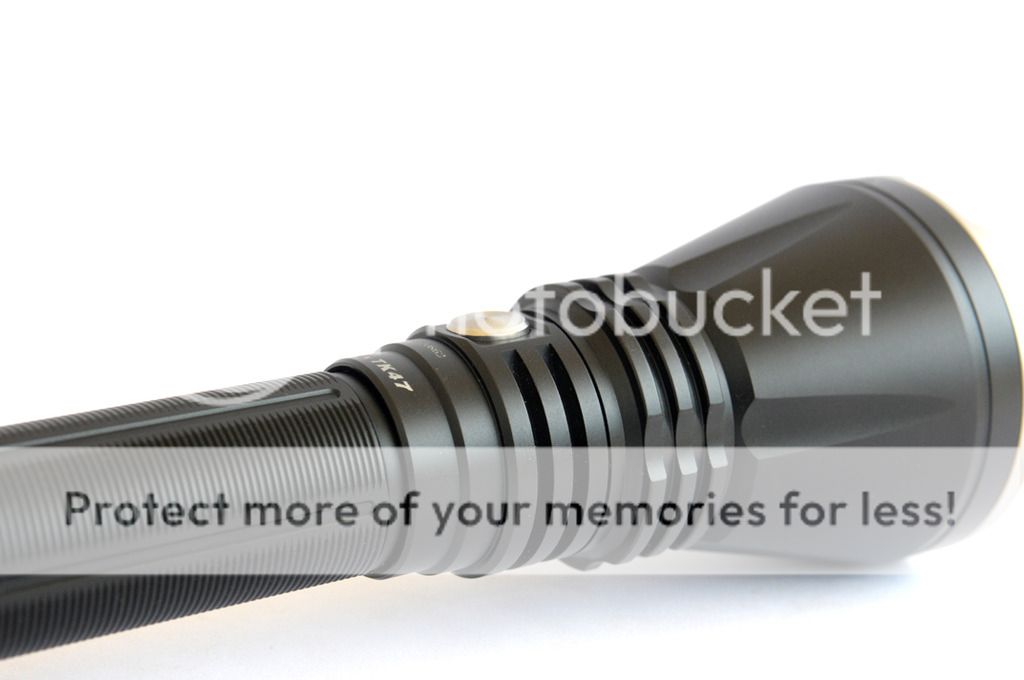
Cooling fins surround the area of the flashlight that develops more heat.


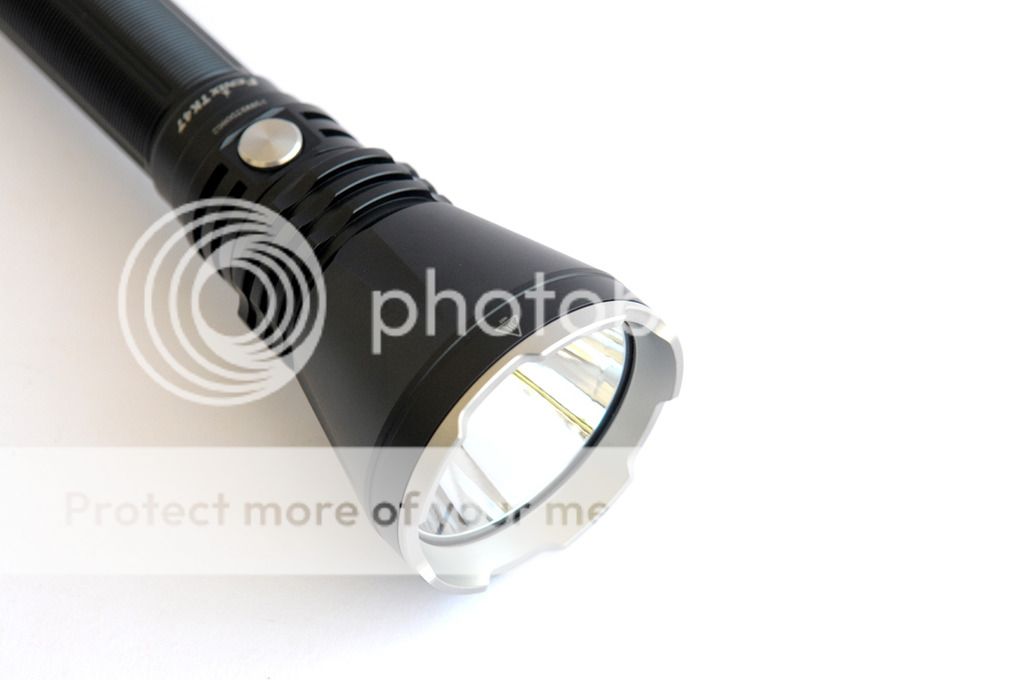
The XHP35 HI led is placed perfectly centered at the bottom of a deep reflector with SMO finish without any defect. A toughened ultra-clear lens with anti-reflective coating (hue on pink) protects the reflector while a stainless steel crenelated bezel protrudes from the head.
The profile of the bezel is common to the TK family and in addition to giving a good aesthetic impact caused by the contrast between steel and aluminum, can serve as strike bezel i.e. for glass breaking
The head is assembled with extreme care in accordance with the qualitative canons of the best Fenix.
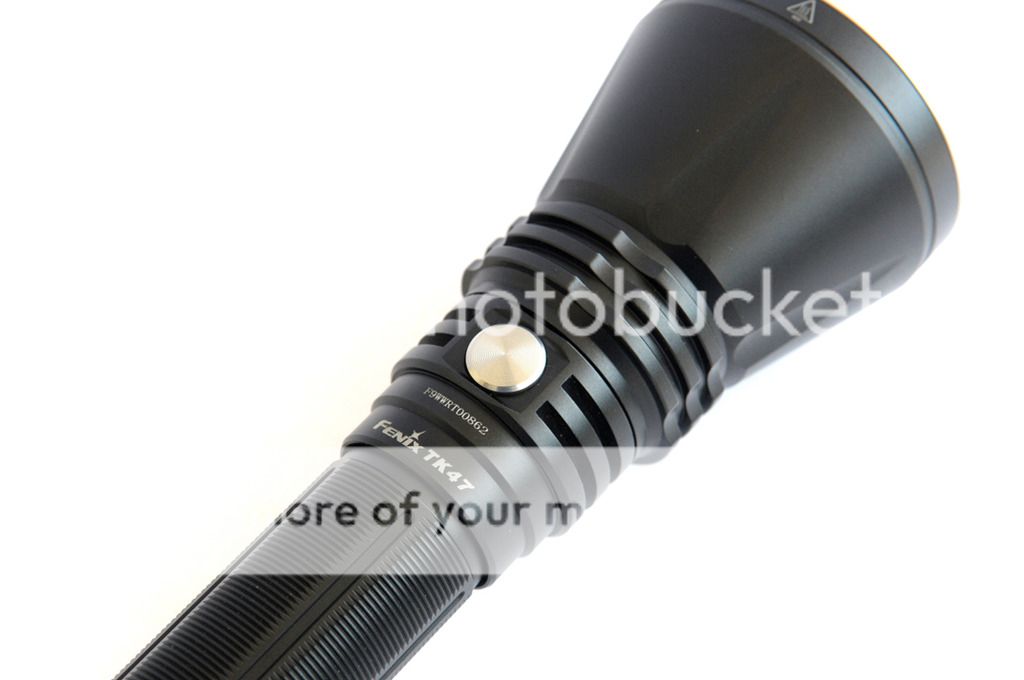
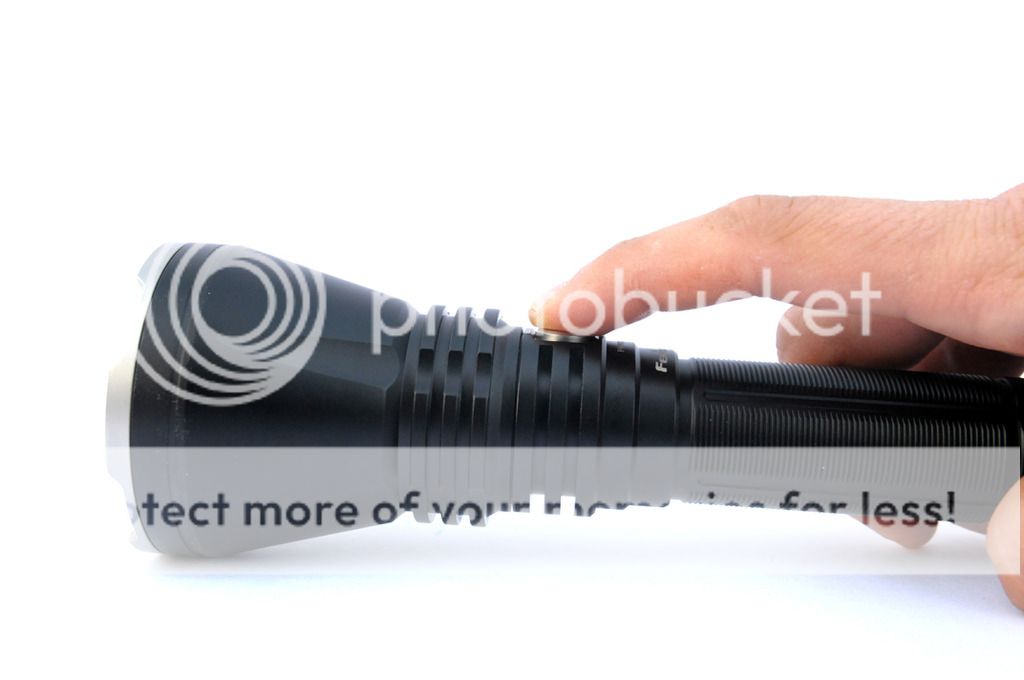
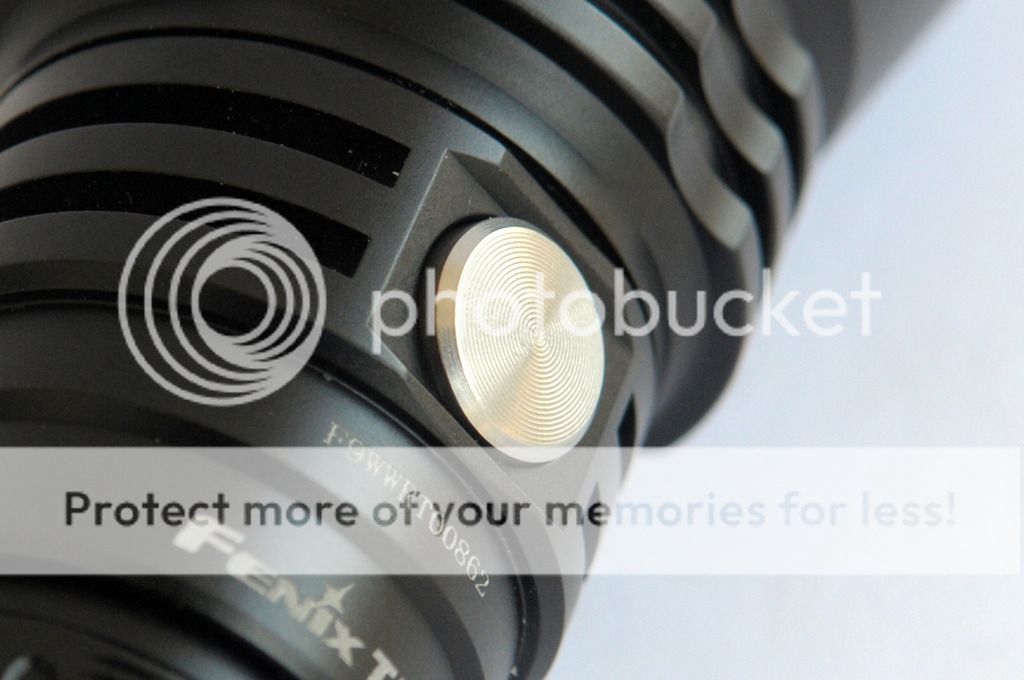
The side button that operates the main LED is of stainless steel and protrudes by a few mm from the flashlight's body.
The tactile feedback is great thanks to the surface with grippy treatment, large enough to be easy detected : it's not difficult to find the button in the dark.
There is no need to apply much pressure, the electronic side switch is easy to operate.
To avoid accidental start a lock-out function is present in UI.


The central body where the two 18650 are placed in series is divisible into two sections with different machining: the part near the head has a nice knurling helpful to increase the grip with hand especially in wet condition.
The HAIII anodizing, well made, has a anti-abrasive finish in matte black color.


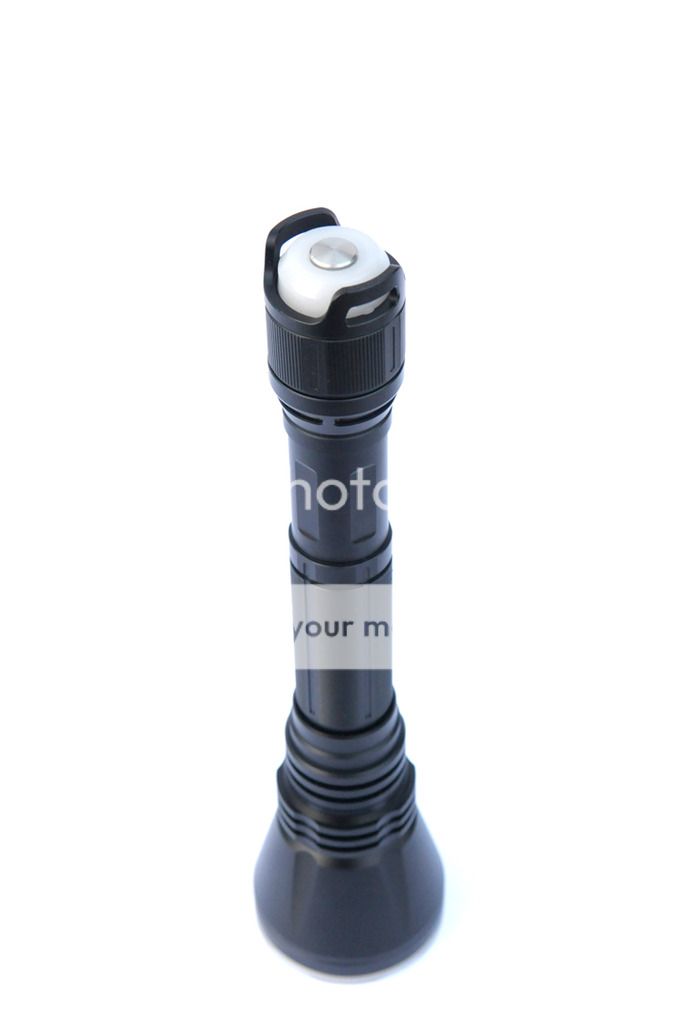

The tailcap is probably the most innovative part of the Fenix TK47 as it is, in fact, a light source independently of the headlight.
The larger sizes distinguish it from a standard tailcap as it contains a stand alone system consisting of driver with switch,leds and diffuser.
A band with knurling takes care to ensure a better grip during the unscrewing.
A dome slightly pointed in opaque plastic is located in the head of the tailcap: this cap, which allows to diffuse the light, is of excellent workmanship and positioned so solid and immovable within the aluminum structure.
Protruding fins provide protection against falls to the diffuser, on wich a stainless steel switch is placed in the center.


To spread the neutral white light or red light, the leds are arranged radially to form a ring around the button, observing the illuminated tailcap you can catch a glimpse of three neutral white leds and three red leds thus forming a series of six diodes for alternating color.

The button is identical both in form and in the finish to that present on the Tk47 side.

The large fins at the edges are widely perforated in the center to allow the insertion of a lanyard such as the one in the packaging and not to impede the diffused light.

Since the fins on the tailcap are flat and the button is recessed the TK47 can be positioned in tailstand which unfortunately is unstable due to the considerable length of the flashlight ( the center of gravity is too near the head).



Both the anode and cathode connections are equipped with gold springs so as to compress the cells in order to avoid power outages which this tactical flashlight may be subjected if mechanically stressed.

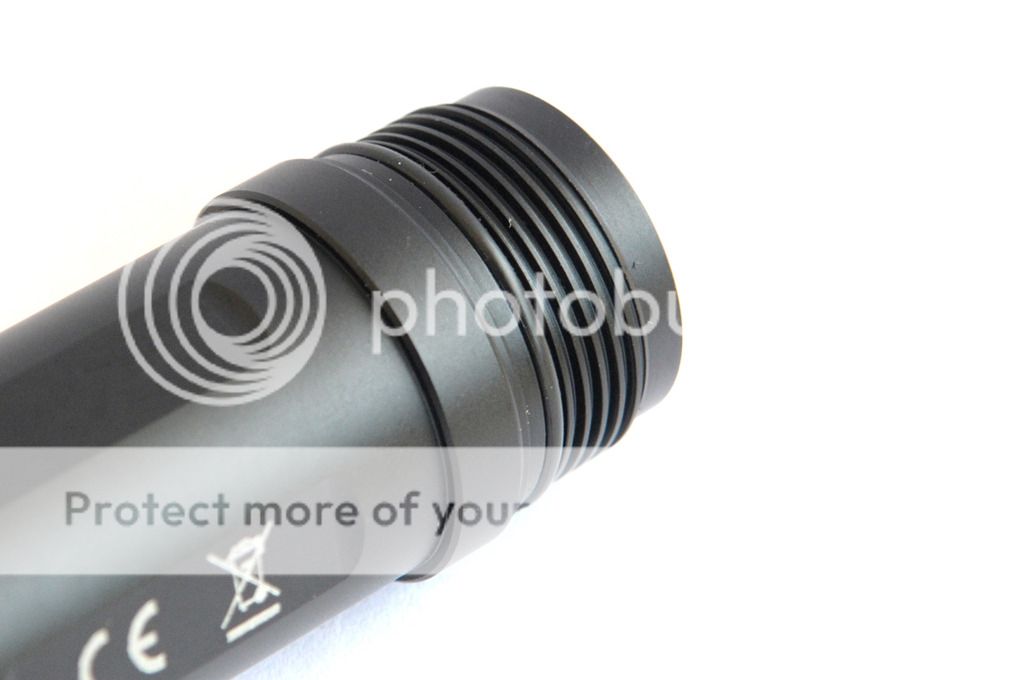
The threads have a square section and are very well machined: the tailcap is grafted without jamming on the body and the rotation is very smooth.
The threading is anodized and then allows the physical lock-out by unscrewing the tailcap of a full turn.
The Fenix TK47 benefits from the maximum index of protection against external agents being classified as IP68. The flashlight can therefore be regarded as dustproof (class 6) being completely sealed and protected from dust and waterproof (class 8) being submersible in water up to 2 meters.


The body structure of the TK47 is made of two layers of aluminum:guarantees circuit stability ed efficiency improving also the structural strength.

The TK47 does not have an anti-rolling design: only the difference in diameter between the head and body can limit this effect which unfortunately easily occurs if the torch is placed on an inclined plane.

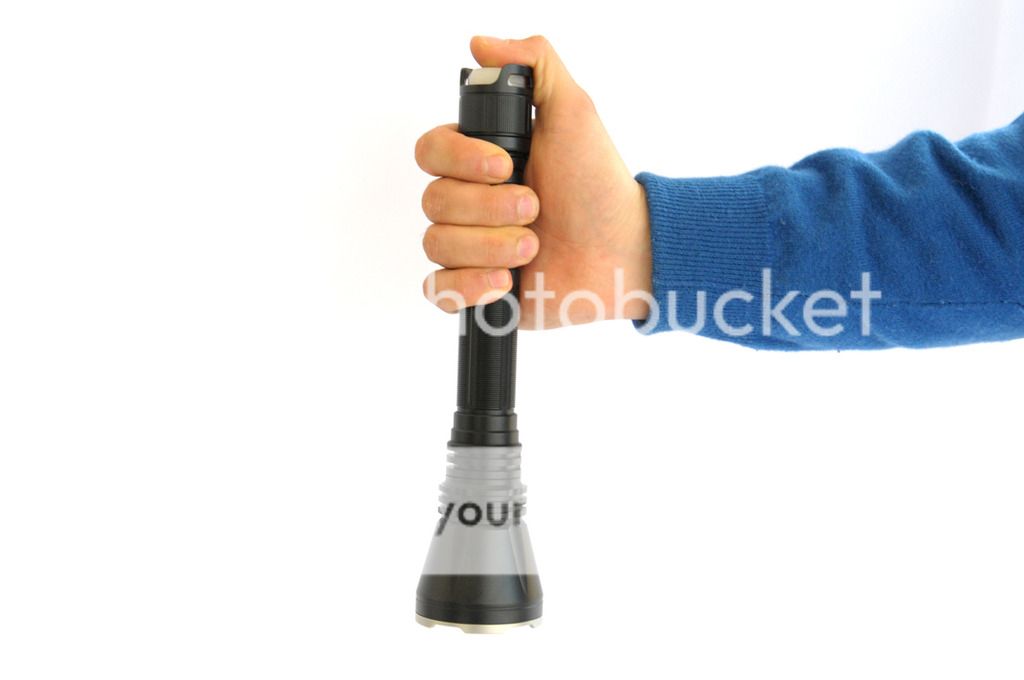
The Fenix TK47 is a bit bulky but the slenderness of the body guarantees an easy and comfortable grip both in standard and "ice pick" position.
Power Source

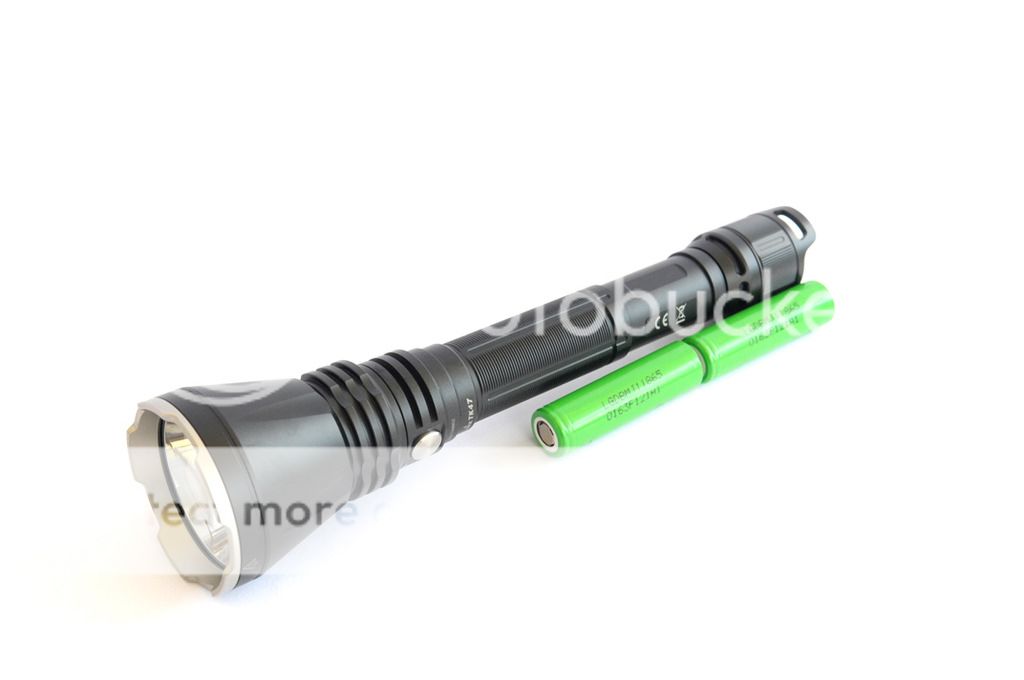
The Fenix TK47 is powered by two 18650 rechargeable Li-ion batteries that must be inserted with the anode side towards the light head. There is a reverse polarity protection from improper battery insertion.
The cells are connected in series and so should not be mixed batteries of different brands, sizes and capacities. The working voltage range is not specified by the manufacturer, only in emergency case, it is possible to use CR123A primary cells in estimated number of four to power the TK47 which will have, in this case, a maximum output of 800 lumens for the headlight and the invariance in output of the tail light.
Given the series configuration it is desirable to use batteries with protection circuit (Fenix recommend its ARB-L18) as well button top cells to ensure proper contact between the negative pole of the first cell and the positive of the second.
In this review i use two LG MJ1 with a neodymium magnet at the center of the configuration.
The TK47 has a clear warning when the voltage of cells decrease: the flashlight will downshift the brightness to lower level until low is reached (will be seen ahead in the run-time test) so in the case of use of non-protected cells, these can be replaced when the output reachs the low level in order to not overdischarge.
Anyway, it is best to check the voltage of each cell periodically to makesure of a correct balance between the two
User Interface
The user interface of the TK47 is simply and allows you to independently manage the headlight with XHP35 HI and the multi-color tail light.
The levels are four on each source, for the headlight Low, Medium, High and Turbo while for the tail there are neutral white light, red light: fixed, S.O.S and Flash.
The dual independent light source can be used simultaneously: for example, to illuminate a target with the main light and at the same time read a map with the secondary red light.
On/Off:
Headlight: press and hold the side switch for 0,5 seconds to turn on/off the light
Tail light: press and hold the side switch for 0,5 seconds to turn on/off the tail light
Output selection:
Headlight: when the light is on, single click of the side switch to cycle through Low->Medium->High->Turbo. There is memory of the last brightness level used.
Tail light: when the light is on, single click of the tail switch to cycle through White Light->Red Light->Red SOS->Red Flash. There is no memory since the tail light start each time from white light.
Strobe: press and hold the side switch for 1,5 seconds to activate strobe(works both in on and off status). A single click to return in general mode.
Lock-Out: When the headlight is off, double click the side switch to enter in lock mode (the flashlight will blink twice to confirm). To unlock double click the side switch.
I like this type of UI but I would have preferred a direct shortcut to turbo level in example double click for turbo and triple click for lock-out.
Beamshot
-Wallshots of the headlight's turbo level and the white/red tail light performed on white wall at about 75/5 cm distance with camera approximately at 1,25m at different exposure times with ISO100 and f2.8 aperture.
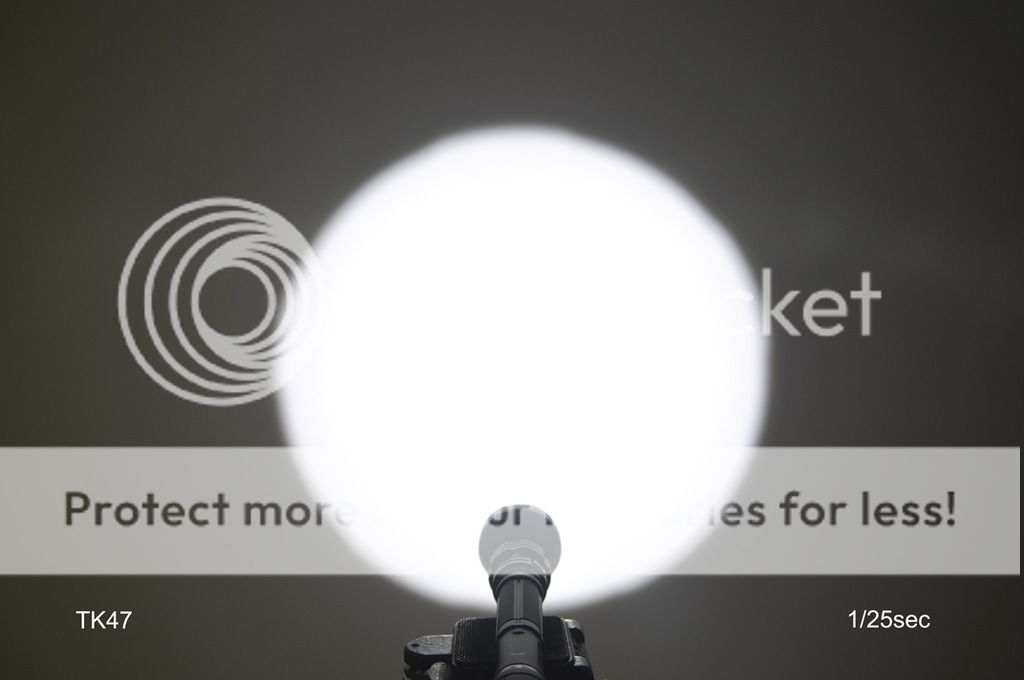


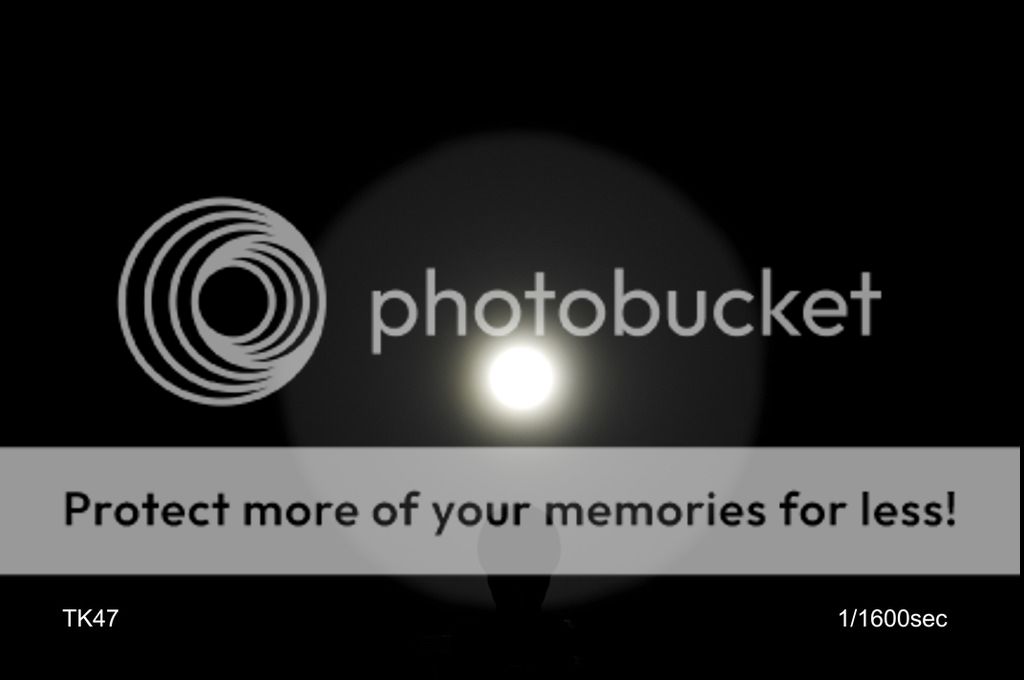
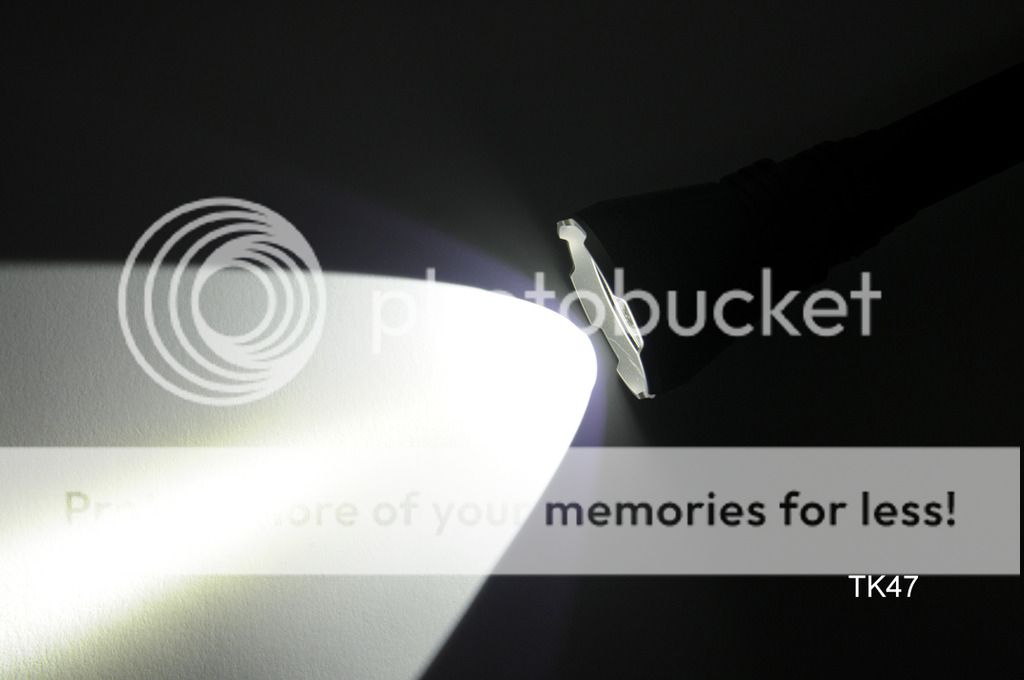
Pointing the TK47 on a white wall, the beam is perceived as having the peculiar characteristics of a good thrower because the hotspot is very bright and persistent on the spill also to exposure times of 1/1600sec
The spill is therefore enough bright as you would expect from a SMO reflector with a dedomed led: the contours are affected only slightly by the machining of the crenelated bezel and in any case this geometry is only visible at very short distances. The beam is clean and free of artifacts or asymmetries as you would expect from a quality flashlight.
Viewing the beam-profile of the TK47 it is possible to see that the spill is large for a thrower.





The light of the tailcap is totally diffused, and so acts like a lantern only for close range.
-External beamshots of the headlight from different camera points to evaluate spot and spill. Used three targets at different distances: 50m tree and two buildings at 200 and 300 meters, tripod height 110cm.



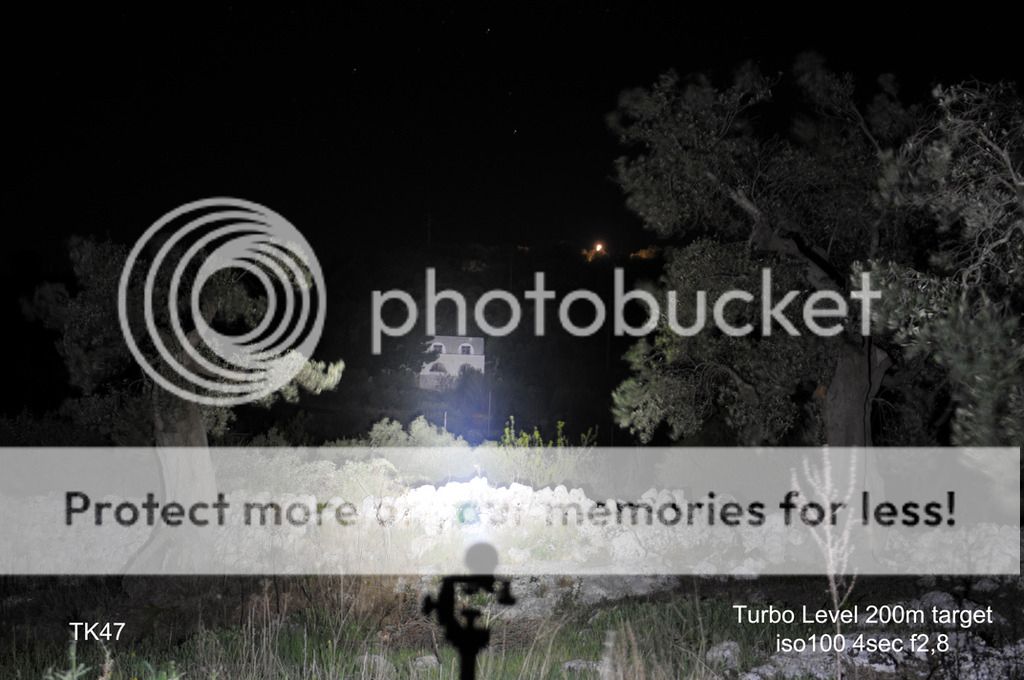




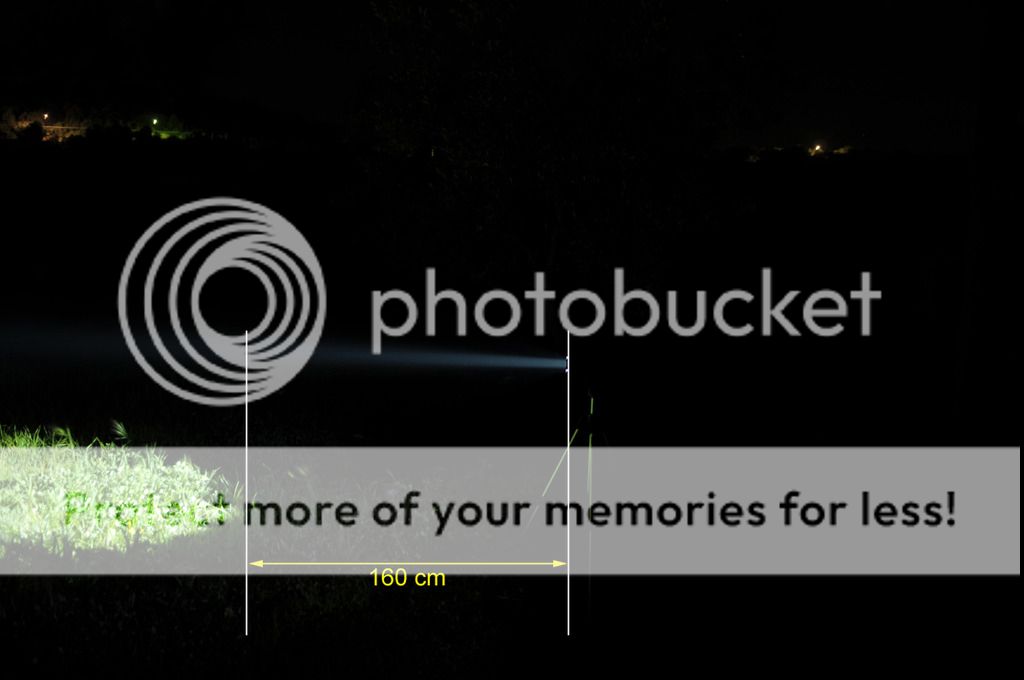
-Beamshots of the TK47 when headlight and red tail light are used together.


-Beamshots of High, Medium and Low levels.



-Beamshots of the white/red tail light.




The Fenix TK47 is a versatile flashlight as it can be used both as a good thrower thanks to the XHP35-HI led and like a total flooder thanks to the leds integrated into tailcap.
With the headlight the TK47 is able to well illuminate targets 300 meters away: the spot stands out as a pure thrower creating a narrow "lightsaber" but the spill remains at the same time large ensuring a good peripheral visibility.
The neutral white tint is very enjoyable in natural environment and offers an excellent three-dimensionality of illuminated objects aswell as a realistic color rendering.
If the flashlight is put parallel to the terrain the distance between the point where the spill starts and user's shoes is around 160 cm.
The output of the tail light is not high but in neutral white light mode is useful as a lantern given that the diffuser does not dazzle the eyes and allows you to enjoy light at 360 °: in this level the fenix TK47 is best if used indoor so that the walls can reflect the light,in outdoor environment will be useful but given the modest output only on very short distances.
The red light mode is very useful if combined with the front light as it is both a signal to indicate its position behind (for example a row of people who follow a guide) both as a useful aid in reading maps or manuals: the red light preserves night vision.
In the flashing red light levels the TK47 it is visible from far away and can be useful to indicate a precise position.
The spacing of the levels is appropriate with various well-spaced outputs. The strobe is in dual fast frequency.
Led and Tint
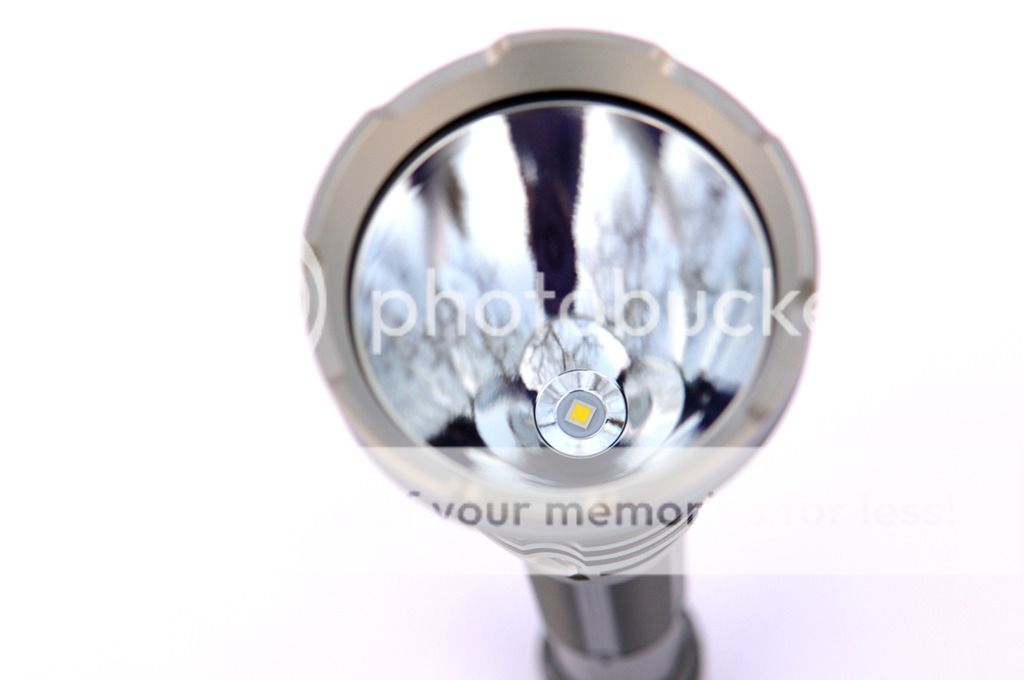
The TK47 is the first Fenix to be equipped with the XHP35 HI offered only in neutral white tint.
As this emitter is only sold in 12V configuration a boost driver is needed in this flashlight but unlike a 1x18650 here the current draw from the single cell is less also taking into account that the output of the TK47 is within specifications of Cree.
It is not specified the type of leds in the tailcap.
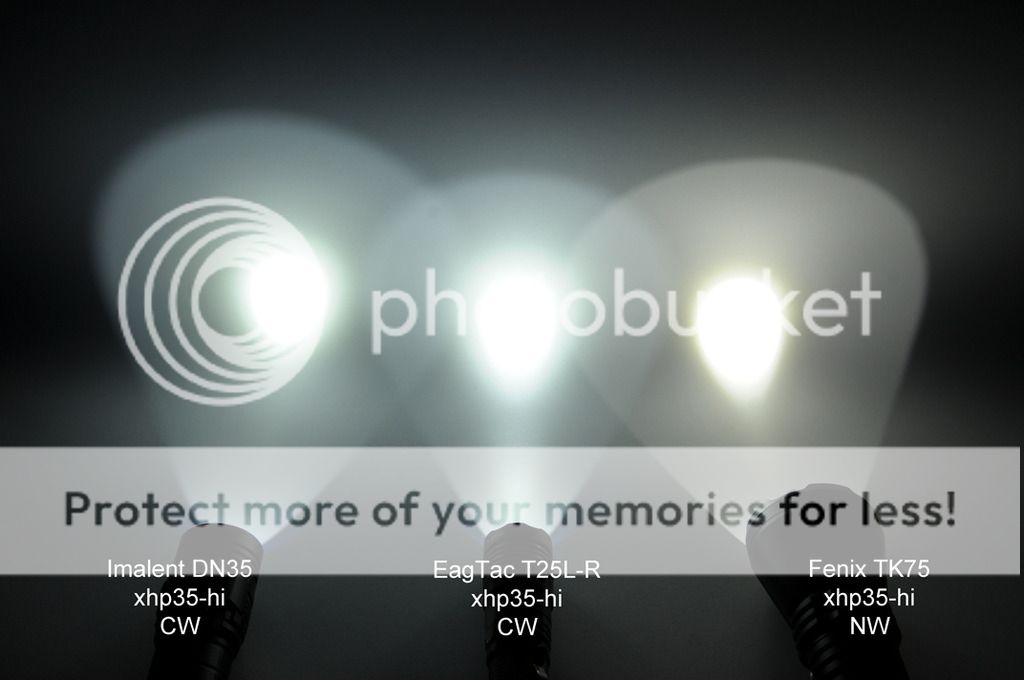

The tint of XHP35 HI is neutral (a bit yellowish around the spot)) with estimated color temperature of around 4700K-5000K. I find really interesting and satisfying that Fenix has decided for this TK only the neutral variant: I hope that other major houses follow this trend.
Surely the output is less than the cold counterpart but it recovers certainly in quality since the TK47 returns an excellent color rendering and behaves very well in fog condition.

Also the tail light has a nice neutral white tint.
Performance

Specs from Fenix.
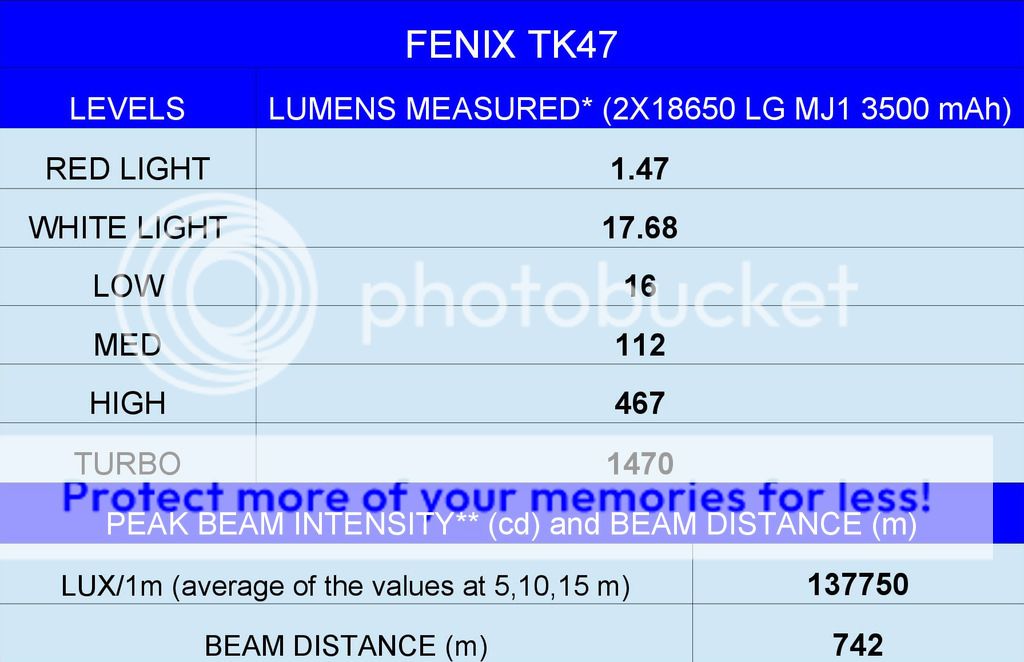
No surprise, I can confirm that the specs declared are consistent. My setup works well with standard flashlight (with reflector) but a lower value for total flood light (i.e. the white tail light) can be possible.
*The output determination was made with the aid of a "lumens tube" taking into account a conversion factor calculated as the average of the values obtained from the ratio between Ansi Lumens (declared from the house) / lux detected of different flashlights (both flooders and throwers)
Each level measurement is take after 30s.
Since the homemade nature of my setup these values can be take as indicative.
**Measurement take after 30s.
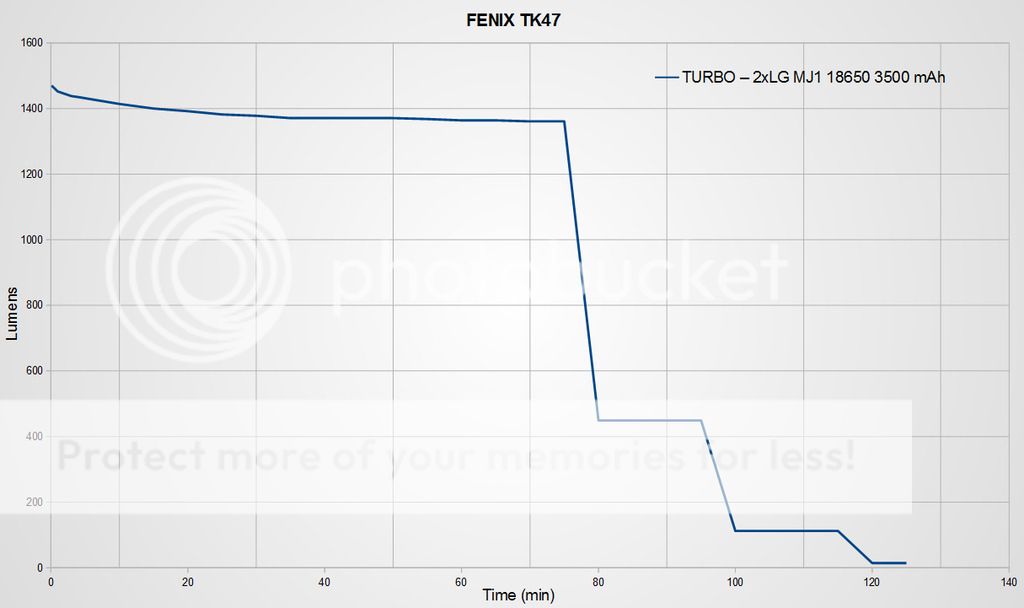
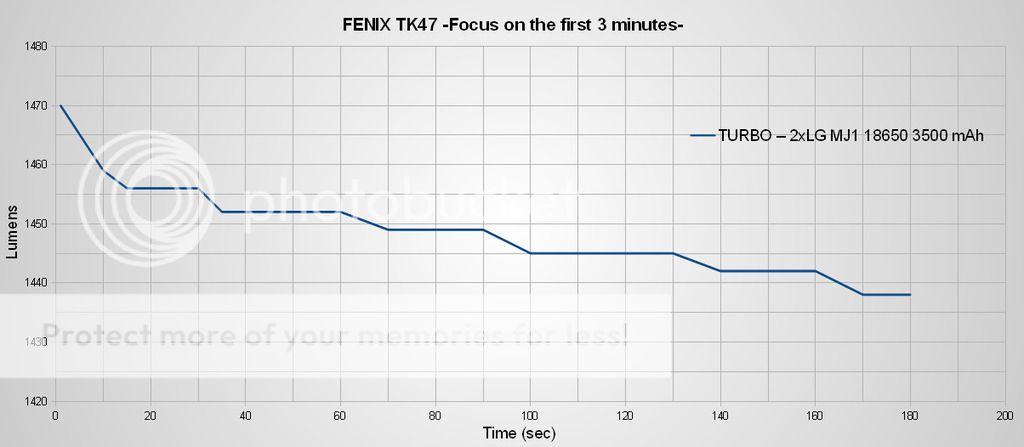
Test done without forced ventilation at an ambient temperature of 17°C.
The TK47 has, at first seen, a "step" brightness stabilization.
Initially for 75 minutes the discharge curve is relatively flat with an output of around 1400 lumens then the light drops at around 450 lumen (High level) and then again after 100 minutes another step-down bring the output to the medium level of 100 lumens.
When the TK47 is on for 115 minutes the Low output (≈14 lumens) is reached: the entire test lasted 200 minutes with the light always at Low.
This regulation is given by the low-voltage downshift function: when the voltage drops below the preset level the flashlight will start downshifting to lower brightness levels until Low is reached. The light will not turn off and will work until the over discharge function stop the batteries from working.
So if unprotected cells are used must pay attention to replace batteries to avoid overdischarging.
In this test the first step-down occurs at total 6,7V while the second and the third to 6,6V and 6.5V, at the end of test after 200 minutes the single cell voltage was equal to 3.2V.

This flashlight features an intelligent overheat protection so to determinate when this occur a test was made comparing the flashlight cooled with a fan with the uncooled situation.
In both cases the trend is almost the same: the output when the flashlight is cooled is more stable for the first 65 minutes determining a premature (respect of the non-cooled) step to the medium level.
I don't find a clear step-down of the output for overheating because the TK47 never reach 65°C (the limit when the protection is activated).
The maximum temperature reached is 59°C after 70 minutes in uncooled test.

Test done without forced ventilation at an ambient temperature of 17°C.
The curve of the High level is perfectly flat for 6 hours until, because of the tension, the step-down occurs. The low level is reached after 400 minutes.
The exact runtime can only be estimated because it is unknown when the output reach the 10% of the initial value due to the step stabilization.
Runtime of Turbo (until downshift to Low)= 120 min
Runtime of High (until downshift to Low)= 405 min
The values from my tests are similar to what is declared from manufacturer.
Final consideration
PROs
+Good throw in neutral white tint.
+Multi functional tail light.
+Each light source is independently controlled
+Very well built.
+Flat stabilization.
+Low voltage downshift function
+Overheat protection
CONs
-The overall length is considerable
-No antirolling design
-The output of the white tail light is too much low.
I am pleasantly surprised with the TK47: the ability to have in the same tool a thrower and if necessary also a widespread flood light both in neutral tint is an innovative novelty in flashlight's world.
In real use the headlight can reach easily 300-400 meters while the tail light is a bright aid for tasks that require a diffused illumination (white light) or for signaling activity and close reading or report writing (red light).
The build quality is excellent as you would expect from a Fenix.
I am very satisfied of the brightness stabilization as the turbo is constant for more than an hour and when the voltage cells drop, to ensure normal use, the light can be operated for more time after the step-down to Low level.
I strongly recommend the use of protected batteries if you are not able to check the voltage of the cells.
For outdoor scenario I would have preferred more output from the white tail light.
The overall length is considerable if we compare the TK47 with its competitors that don't have anyway the nice tail light function.
Thanks for reading.
Fenix TK47 was provided by Fenix for review purpose.
There is also a version equipped with XHP70 and OP reflector called TK47 Ultimate Edition (UE)
REVIEW Fenix TK47 (XHP35 HI NW, Tail Light, 2x18650)








Manufacturer's Specs:
Headlight: Cree XHp35 HI neutral white LED with a lifespan of 50,000 hours
Tail light: Quality neutral white LED, red LED and diffuser tip design
Powered by two 18650 rechargeable Li-ion batteries
10.5″ (266.2mm) Length x 2.4″ (61.5mm) Head Diameter x 1.2″ (28.6mm) Body Diameter
13.2 oz (375g) excluding batteries
Dual independent light source that can be used simultaneously
Headlight with a far-reaching 2296 ft (700m) beam distance
Digitally regulated output maintains constant brightness
Headlight features lockout function
Reverse polarity protection, to protect from improper batter insertion
Intelligent over-heat protection to avoid high temperature of the surface
Featuring low voltage downshift function
Made of durable aircraft-grade aluminum
Premium type III hard-anodized anti-abrasive finish
Toughened ultra-clear glass lens with anti-reflective coating
Packaging and accessories


The Fenix TK47 is presented in a cardboard box with handle for transportation, are imprinted externally all the technical characteristics of the flashlight.

The Fenix TK47 kit of accessories includes: holster, lanyard, spare o-ring , multilanguage user manual, warranty card.



The cordura holster is well made and covers, given the remarkable length of the TK47, only the head of the flashlight allowing an upward carry.
The holster is closable with hook-and-loop fastener, the belt loop is wide enough for tactical belt.
Additional hooking attachments are MOLLE compatible connection and a plastic D-ring.

The lanyard is made of paracord.
How it's made


The TK47 is a new tactical flashlight from Fenix, powered by 2x18650, fitted with recent XHP35-HI led and smooth reflector, capable of a long range illumination of around 700 m.
A white/red tail light with integrated diffuser permits to use the flashlight like a white light soft lantern, for report writing using the red light or for signaling thanks to the red flash/SOS.
Each light source,independently controlled by the dedicated switch, is available in four levels so that the needs of the user can be satisfied.
Both the headlight and the tail light are in neutral tint providing a better color rendering.


The design of this Fenix fully reflects the TK family of models, to which it belongs, that stand out for the finish tactics and sturdy construction.
Engravings are present on the flashlight pertaining to the model,serial number and CE certification.

The throw attitude is ensured by a generous size head that houses the factory dedomed led.



In the pics a dimensional comparison with XHP35 HI equipped lights, at left Imalent DN35 at right EagTac T25L-R.

With KaBar USMC.

The TK47 shows a dimensional profile which reveals a clear distinction between the head with a diameter of more than 60mm and the much more streamlined central body.
The dimensions are peculiar of tactical throwers in 2x18650 format that allows considerable performance in range while remaining easily grasped as a normal mono 18650, obviously it must be taken into consideration that the adoption of the two cells in series, brings the total length to become important. These dimensional sizes make the TK47 not an EDC but rather a searchlight to carry for a specific purpose.
The thickness is truly remarkable and indication of the renowned robustness of Fenix TK.



The head of the TK47 is basically divided into two parts: the one from the "cone with flat top" profile where there is the reflector ed in another from the cylindrical profile where it is present the driver with the side switch to manage the UI of the headlight.
The head parts are connected with each other and with the central body by threads, locked mechanically with threadlocking fluid.

Cooling fins surround the area of the flashlight that develops more heat.



The XHP35 HI led is placed perfectly centered at the bottom of a deep reflector with SMO finish without any defect. A toughened ultra-clear lens with anti-reflective coating (hue on pink) protects the reflector while a stainless steel crenelated bezel protrudes from the head.
The profile of the bezel is common to the TK family and in addition to giving a good aesthetic impact caused by the contrast between steel and aluminum, can serve as strike bezel i.e. for glass breaking
The head is assembled with extreme care in accordance with the qualitative canons of the best Fenix.



The side button that operates the main LED is of stainless steel and protrudes by a few mm from the flashlight's body.
The tactile feedback is great thanks to the surface with grippy treatment, large enough to be easy detected : it's not difficult to find the button in the dark.
There is no need to apply much pressure, the electronic side switch is easy to operate.
To avoid accidental start a lock-out function is present in UI.


The central body where the two 18650 are placed in series is divisible into two sections with different machining: the part near the head has a nice knurling helpful to increase the grip with hand especially in wet condition.
The HAIII anodizing, well made, has a anti-abrasive finish in matte black color.




The tailcap is probably the most innovative part of the Fenix TK47 as it is, in fact, a light source independently of the headlight.
The larger sizes distinguish it from a standard tailcap as it contains a stand alone system consisting of driver with switch,leds and diffuser.
A band with knurling takes care to ensure a better grip during the unscrewing.
A dome slightly pointed in opaque plastic is located in the head of the tailcap: this cap, which allows to diffuse the light, is of excellent workmanship and positioned so solid and immovable within the aluminum structure.
Protruding fins provide protection against falls to the diffuser, on wich a stainless steel switch is placed in the center.


To spread the neutral white light or red light, the leds are arranged radially to form a ring around the button, observing the illuminated tailcap you can catch a glimpse of three neutral white leds and three red leds thus forming a series of six diodes for alternating color.

The button is identical both in form and in the finish to that present on the Tk47 side.

The large fins at the edges are widely perforated in the center to allow the insertion of a lanyard such as the one in the packaging and not to impede the diffused light.

Since the fins on the tailcap are flat and the button is recessed the TK47 can be positioned in tailstand which unfortunately is unstable due to the considerable length of the flashlight ( the center of gravity is too near the head).



Both the anode and cathode connections are equipped with gold springs so as to compress the cells in order to avoid power outages which this tactical flashlight may be subjected if mechanically stressed.


The threads have a square section and are very well machined: the tailcap is grafted without jamming on the body and the rotation is very smooth.
The threading is anodized and then allows the physical lock-out by unscrewing the tailcap of a full turn.
The Fenix TK47 benefits from the maximum index of protection against external agents being classified as IP68. The flashlight can therefore be regarded as dustproof (class 6) being completely sealed and protected from dust and waterproof (class 8) being submersible in water up to 2 meters.


The body structure of the TK47 is made of two layers of aluminum:guarantees circuit stability ed efficiency improving also the structural strength.

The TK47 does not have an anti-rolling design: only the difference in diameter between the head and body can limit this effect which unfortunately easily occurs if the torch is placed on an inclined plane.


The Fenix TK47 is a bit bulky but the slenderness of the body guarantees an easy and comfortable grip both in standard and "ice pick" position.
Power Source


The Fenix TK47 is powered by two 18650 rechargeable Li-ion batteries that must be inserted with the anode side towards the light head. There is a reverse polarity protection from improper battery insertion.
The cells are connected in series and so should not be mixed batteries of different brands, sizes and capacities. The working voltage range is not specified by the manufacturer, only in emergency case, it is possible to use CR123A primary cells in estimated number of four to power the TK47 which will have, in this case, a maximum output of 800 lumens for the headlight and the invariance in output of the tail light.
Given the series configuration it is desirable to use batteries with protection circuit (Fenix recommend its ARB-L18) as well button top cells to ensure proper contact between the negative pole of the first cell and the positive of the second.
In this review i use two LG MJ1 with a neodymium magnet at the center of the configuration.
The TK47 has a clear warning when the voltage of cells decrease: the flashlight will downshift the brightness to lower level until low is reached (will be seen ahead in the run-time test) so in the case of use of non-protected cells, these can be replaced when the output reachs the low level in order to not overdischarge.
Anyway, it is best to check the voltage of each cell periodically to makesure of a correct balance between the two
User Interface
The user interface of the TK47 is simply and allows you to independently manage the headlight with XHP35 HI and the multi-color tail light.
The levels are four on each source, for the headlight Low, Medium, High and Turbo while for the tail there are neutral white light, red light: fixed, S.O.S and Flash.
The dual independent light source can be used simultaneously: for example, to illuminate a target with the main light and at the same time read a map with the secondary red light.
On/Off:
Headlight: press and hold the side switch for 0,5 seconds to turn on/off the light
Tail light: press and hold the side switch for 0,5 seconds to turn on/off the tail light
Output selection:
Headlight: when the light is on, single click of the side switch to cycle through Low->Medium->High->Turbo. There is memory of the last brightness level used.
Tail light: when the light is on, single click of the tail switch to cycle through White Light->Red Light->Red SOS->Red Flash. There is no memory since the tail light start each time from white light.
Strobe: press and hold the side switch for 1,5 seconds to activate strobe(works both in on and off status). A single click to return in general mode.
Lock-Out: When the headlight is off, double click the side switch to enter in lock mode (the flashlight will blink twice to confirm). To unlock double click the side switch.
I like this type of UI but I would have preferred a direct shortcut to turbo level in example double click for turbo and triple click for lock-out.
Beamshot
-Wallshots of the headlight's turbo level and the white/red tail light performed on white wall at about 75/5 cm distance with camera approximately at 1,25m at different exposure times with ISO100 and f2.8 aperture.





Pointing the TK47 on a white wall, the beam is perceived as having the peculiar characteristics of a good thrower because the hotspot is very bright and persistent on the spill also to exposure times of 1/1600sec
The spill is therefore enough bright as you would expect from a SMO reflector with a dedomed led: the contours are affected only slightly by the machining of the crenelated bezel and in any case this geometry is only visible at very short distances. The beam is clean and free of artifacts or asymmetries as you would expect from a quality flashlight.
Viewing the beam-profile of the TK47 it is possible to see that the spill is large for a thrower.





The light of the tailcap is totally diffused, and so acts like a lantern only for close range.
-External beamshots of the headlight from different camera points to evaluate spot and spill. Used three targets at different distances: 50m tree and two buildings at 200 and 300 meters, tripod height 110cm.









-Beamshots of the TK47 when headlight and red tail light are used together.


-Beamshots of High, Medium and Low levels.



-Beamshots of the white/red tail light.




The Fenix TK47 is a versatile flashlight as it can be used both as a good thrower thanks to the XHP35-HI led and like a total flooder thanks to the leds integrated into tailcap.
With the headlight the TK47 is able to well illuminate targets 300 meters away: the spot stands out as a pure thrower creating a narrow "lightsaber" but the spill remains at the same time large ensuring a good peripheral visibility.
The neutral white tint is very enjoyable in natural environment and offers an excellent three-dimensionality of illuminated objects aswell as a realistic color rendering.
If the flashlight is put parallel to the terrain the distance between the point where the spill starts and user's shoes is around 160 cm.
The output of the tail light is not high but in neutral white light mode is useful as a lantern given that the diffuser does not dazzle the eyes and allows you to enjoy light at 360 °: in this level the fenix TK47 is best if used indoor so that the walls can reflect the light,in outdoor environment will be useful but given the modest output only on very short distances.
The red light mode is very useful if combined with the front light as it is both a signal to indicate its position behind (for example a row of people who follow a guide) both as a useful aid in reading maps or manuals: the red light preserves night vision.
In the flashing red light levels the TK47 it is visible from far away and can be useful to indicate a precise position.
The spacing of the levels is appropriate with various well-spaced outputs. The strobe is in dual fast frequency.
Led and Tint

The TK47 is the first Fenix to be equipped with the XHP35 HI offered only in neutral white tint.
As this emitter is only sold in 12V configuration a boost driver is needed in this flashlight but unlike a 1x18650 here the current draw from the single cell is less also taking into account that the output of the TK47 is within specifications of Cree.
It is not specified the type of leds in the tailcap.


The tint of XHP35 HI is neutral (a bit yellowish around the spot)) with estimated color temperature of around 4700K-5000K. I find really interesting and satisfying that Fenix has decided for this TK only the neutral variant: I hope that other major houses follow this trend.
Surely the output is less than the cold counterpart but it recovers certainly in quality since the TK47 returns an excellent color rendering and behaves very well in fog condition.

Also the tail light has a nice neutral white tint.
Performance

Specs from Fenix.

No surprise, I can confirm that the specs declared are consistent. My setup works well with standard flashlight (with reflector) but a lower value for total flood light (i.e. the white tail light) can be possible.
*The output determination was made with the aid of a "lumens tube" taking into account a conversion factor calculated as the average of the values obtained from the ratio between Ansi Lumens (declared from the house) / lux detected of different flashlights (both flooders and throwers)
Each level measurement is take after 30s.
Since the homemade nature of my setup these values can be take as indicative.
**Measurement take after 30s.


Test done without forced ventilation at an ambient temperature of 17°C.
The TK47 has, at first seen, a "step" brightness stabilization.
Initially for 75 minutes the discharge curve is relatively flat with an output of around 1400 lumens then the light drops at around 450 lumen (High level) and then again after 100 minutes another step-down bring the output to the medium level of 100 lumens.
When the TK47 is on for 115 minutes the Low output (≈14 lumens) is reached: the entire test lasted 200 minutes with the light always at Low.
This regulation is given by the low-voltage downshift function: when the voltage drops below the preset level the flashlight will start downshifting to lower brightness levels until Low is reached. The light will not turn off and will work until the over discharge function stop the batteries from working.
So if unprotected cells are used must pay attention to replace batteries to avoid overdischarging.
In this test the first step-down occurs at total 6,7V while the second and the third to 6,6V and 6.5V, at the end of test after 200 minutes the single cell voltage was equal to 3.2V.

This flashlight features an intelligent overheat protection so to determinate when this occur a test was made comparing the flashlight cooled with a fan with the uncooled situation.
In both cases the trend is almost the same: the output when the flashlight is cooled is more stable for the first 65 minutes determining a premature (respect of the non-cooled) step to the medium level.
I don't find a clear step-down of the output for overheating because the TK47 never reach 65°C (the limit when the protection is activated).
The maximum temperature reached is 59°C after 70 minutes in uncooled test.

Test done without forced ventilation at an ambient temperature of 17°C.
The curve of the High level is perfectly flat for 6 hours until, because of the tension, the step-down occurs. The low level is reached after 400 minutes.
The exact runtime can only be estimated because it is unknown when the output reach the 10% of the initial value due to the step stabilization.
Runtime of Turbo (until downshift to Low)= 120 min
Runtime of High (until downshift to Low)= 405 min
The values from my tests are similar to what is declared from manufacturer.
Final consideration
PROs
+Good throw in neutral white tint.
+Multi functional tail light.
+Each light source is independently controlled
+Very well built.
+Flat stabilization.
+Low voltage downshift function
+Overheat protection
CONs
-The overall length is considerable
-No antirolling design
-The output of the white tail light is too much low.
I am pleasantly surprised with the TK47: the ability to have in the same tool a thrower and if necessary also a widespread flood light both in neutral tint is an innovative novelty in flashlight's world.
In real use the headlight can reach easily 300-400 meters while the tail light is a bright aid for tasks that require a diffused illumination (white light) or for signaling activity and close reading or report writing (red light).
The build quality is excellent as you would expect from a Fenix.
I am very satisfied of the brightness stabilization as the turbo is constant for more than an hour and when the voltage cells drop, to ensure normal use, the light can be operated for more time after the step-down to Low level.
I strongly recommend the use of protected batteries if you are not able to check the voltage of the cells.
For outdoor scenario I would have preferred more output from the white tail light.
The overall length is considerable if we compare the TK47 with its competitors that don't have anyway the nice tail light function.
Thanks for reading.
Last edited:

